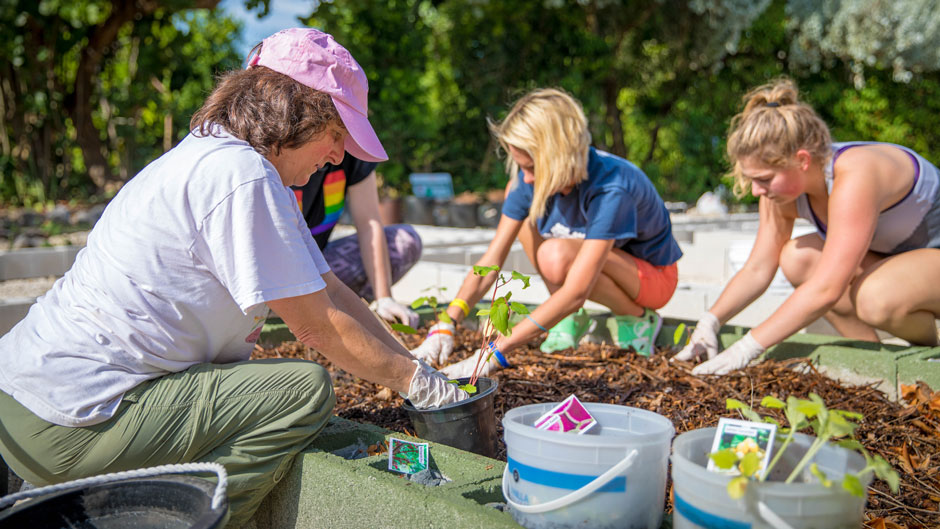Before coming to the University of Miami, Manel Seridji had never planted her own vegetables, weeded, or learned about the nutritional value of the edible hibiscus plant. As a native of Paris, France, she simply did not have the opportunity to garden.
Yet last year, she took one of Professor Richard Weisskoff’s classes where Seridji got to spend time gardening. She found the class refreshing. So refreshing that she is in another one of his classes now.
“Taking this class really opened my mind and I feel relaxed when I do this — I feel happy,” said Seridji, an International Studies sophomore. “I’ve also learned a lot about the properties of plants.”
On a recent afternoon, Weisskoff touted the benefits of the cranberry hibiscus plant, which can be used as lettuce, or cooked like spinach, he said, while munching on a leaf. They were one of the first plants he included in his original garden on campus, started in 2017 and titled the Global Student Farm. Now other perennial vegetables, such as banana plants, lemongrass and pigeon peas tower above his head. Although Weisskoff teaches International Studies courses at the University of Miami, he focuses on development in Latin America, which is heavily tied to agriculture.
“The way you learn agriculture is you work with someone who knows it,” Weisskoff said, recalling summers in Puerto Rico, Peru and Paraguay where he spent time as a farmhand to guide his economic research. “At first, I was told students at UM are not going to do that…but students that love [gardening] are everybody. We link into a need in people not only to do book learning, but to do the kind of learning that allows them to watch a sprout grow and then learn how to cook it.”
Weisskoff is one of three professors on campus who have integrated gardening into their classes. Abess Center for Ecosystem Science and Policy Professor Terri Hood, who specializes in environmental science and geology, has been working to create a garden that could be used in UM classes for years. Working with the University’s Sustainability Department and the John C. Gifford Arboretum, this fall Hood began using a garden space tucked in the arboretum, in what was once a landscape debris area.
The Sustainable Suburbia garden is now being shared by Hood and Professor Kathleen Sealey, who are teaching a course together, as well as Weisskoff’s class. There are also plans for the CommUnity Garden Club, as well as other professors with interest to take on future plots, Hood said.
It is the first time UM has devoted a permanent garden space for classroom use, and the professors involved are hoping that it will encourage students to create their own sustainable gardens at home.
“We are teaching people how to manage their yards in a useful way for people and suburban wildlife,” said Hood. “We are trying to encourage lower fertilizer use, less of a water-greedy environment, and the use of natural pest control measures.”
UM’s Sustainability Manager Teddy Lhoutellier, who also helped plan the garden and built a composting device for it, said the classes are using an agricultural philosophy called permaculture to create easy-to-maintain vegetable gardens. For example, recently, Hood taught her students how to layer the soil so that it will retain water better. She guided them as they covered the first “trial bed” with large waste posters, topped that with leftover branches, then added soil from an old garden, donated rabbit manure, and a layer of mulch and coffee grounds.
After prepping the soil, the students planted two different types of radishes, some bok choy, a few lemon cucumber plants and some red burgundy okra. These annuals will supplement an existing plot of tropical perennials, including bananas, malanga, cassava and pineapple plants. The idea is that each semester, the students will replant in the “trial beds,” Hood said, building up the healthy soil from the hard limestone beneath.
The garden is truly a cooperative effort. Ecosystem Science and Policy (ECS) students designed the layout of the garden last spring in one of Hood’s courses on permaculture, and geology students brought back river sand from their hometowns to help release nutrients into the soil, Hood added. As part of Hood’s class, students must sign up for the watering schedule, which is passed out weekly. Weisskoff’s students must bring in produce waste for the composter.
Sustainability garden manager Talula Thibault has been documenting the progress, and helping to build the garden on Wednesday afternoons, from placing the cinderblock edging on the trial beds, to filling watering buckets, to mixing compost, along with a few other garden-savvy volunteers. Although Thibault would like to enter the business world after college, the garden has become her oasis and she spends afternoons there weeding.
“It’s really never going to be done, that’s the beauty of it,” said Thibault, an Economics and ECS junior. “The garden will be here for generations to come. It’s ever changing and never quite perfectly ‘finished,’ but always alluring.”
Arboretum Director Steve Pearson has also helped make the garden a reality by lending space to the professors. Pearson said the benefits of students spending time in the arboretum and interacting with plants are endless.
“Students today need a better understanding of plants in the world, not just for food, but for clean air and water, oxygen production, and a myriad of other things,” he said. “They are part of the fabric of our environment and without plants, we would die.”
UM students, faculty and staff are welcome to help care for the garden. If you would like to volunteer, contact Professor Terri Hood via email at thood@rsmas.miami.edu
